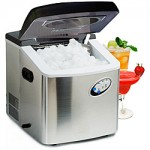Ice is essential in any food and drink industry. Restaurants, food and beverage factories, and similar businesses cannot do without ice. One of the uses of ice is to keep the food and drink in the right temperature, while there are some businesses that require their food and drink frozen to preserve its high quality. Due to constant need, the right manufacturing and storing of ice are crucial matters.
GB450_B310If you are entering the food and beverage industry and ice will be constantly needed in the course of your operation, sourcing ice makers is one of your initial steps. For a start-up business, you may initially use an affordable commercial pellet ice maker. With proper maintenance, correct handling, and right amount of care, your ice maker may serve you for years.
When buying an ice maker, there are few relevant factors that you have to keep in mind. These factors have a great impact in your decision-making which will also lead you to the right ice maker that suits your business.
First, determine the size of the ice maker and ice storage. This can be determined by assessing the demand of ice per day. In a restaurant, one customer usually consumes about 2 pounds of ice per dine-in. Take note that apart from the ice you will be serving the guest to keep their fountain sodas, cocktails, and other refreshments cold and chilling, you also need ice to preserve your stock in the fridge, such as meat, fish, vegetables, drinks, desserts, and other similar items. If you have a salad bar in your restaurant, that requires the use of ice as well.
Ice MakerThe amount of ice needed in food and beverage business is always large and investing on a large ice maker and storage is a smart move. The ice maker should be able to handle the demand of the business, and must be able to produce the right amount of ice most especially during peak hours of the operation. On a relatively “low” day, the ice maker can produce ahead in preparation for “high” days where customers are coming non-stop and ice constantly served.
Ice makers generally produce three kinds of ice: nuggets, flakes and cubes. In restaurants, the cube-type is in-demand as it is the one being served to the customers along with the beverage products they ordered. The nugget type is ideal as well, and is actually being used in more and more restaurants nowadays because of its “slow-melt” features which make it economical. Meanwhile, the flake-type is mostly used in the kitchen to maintain the cool temperature of seafood, or in salad bars to keep the vegetables cold and fresh.